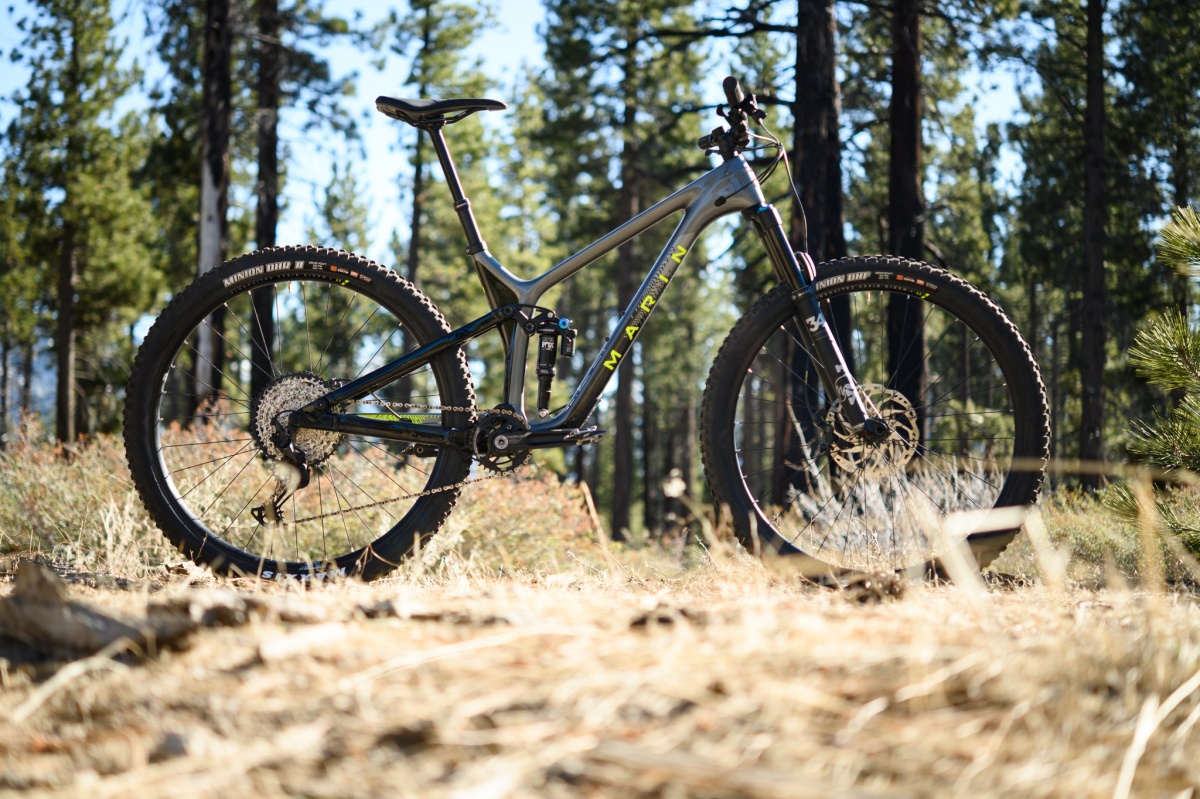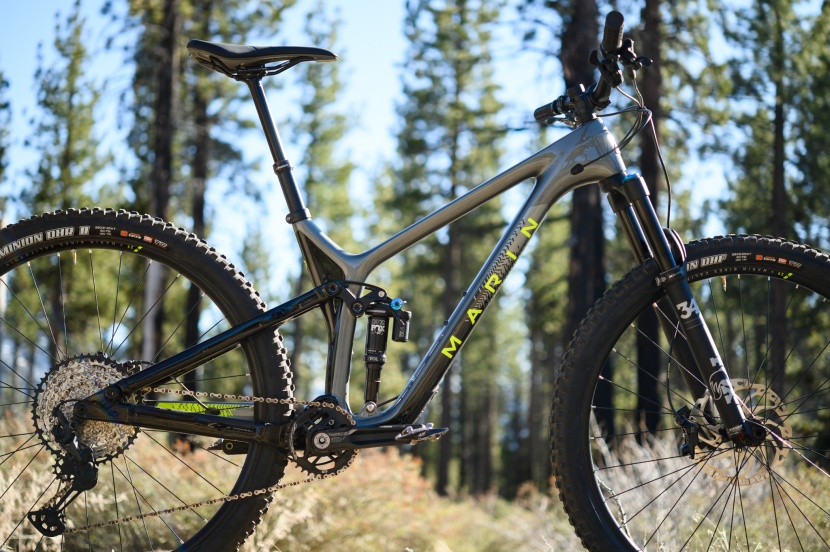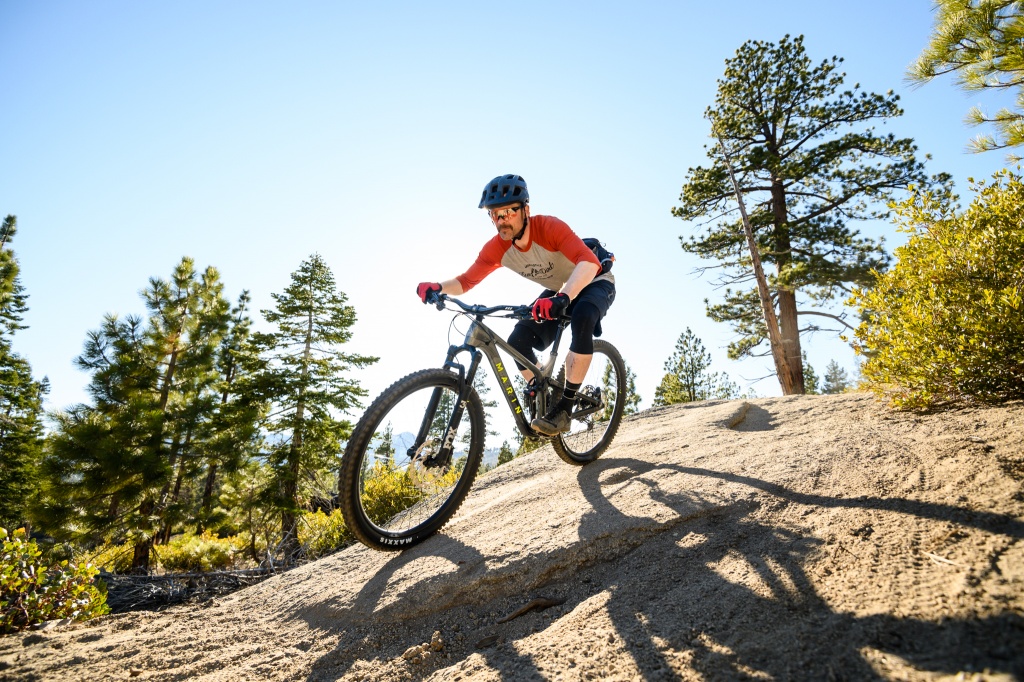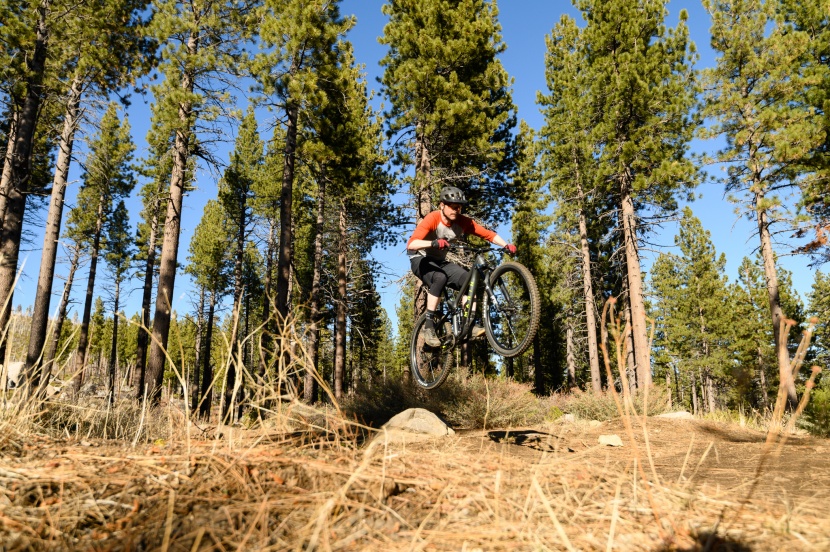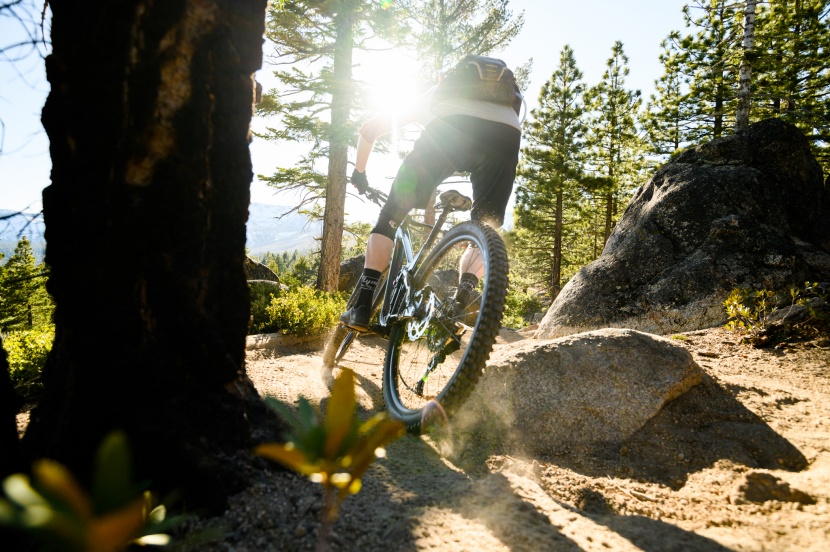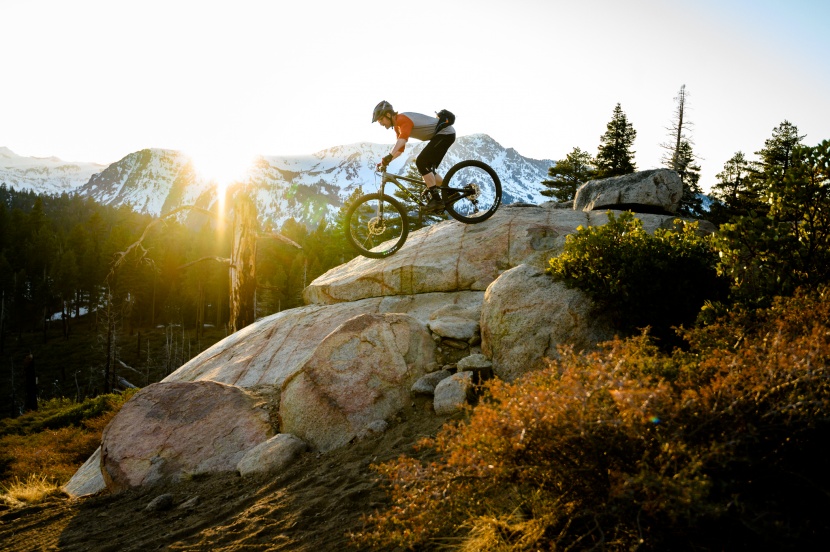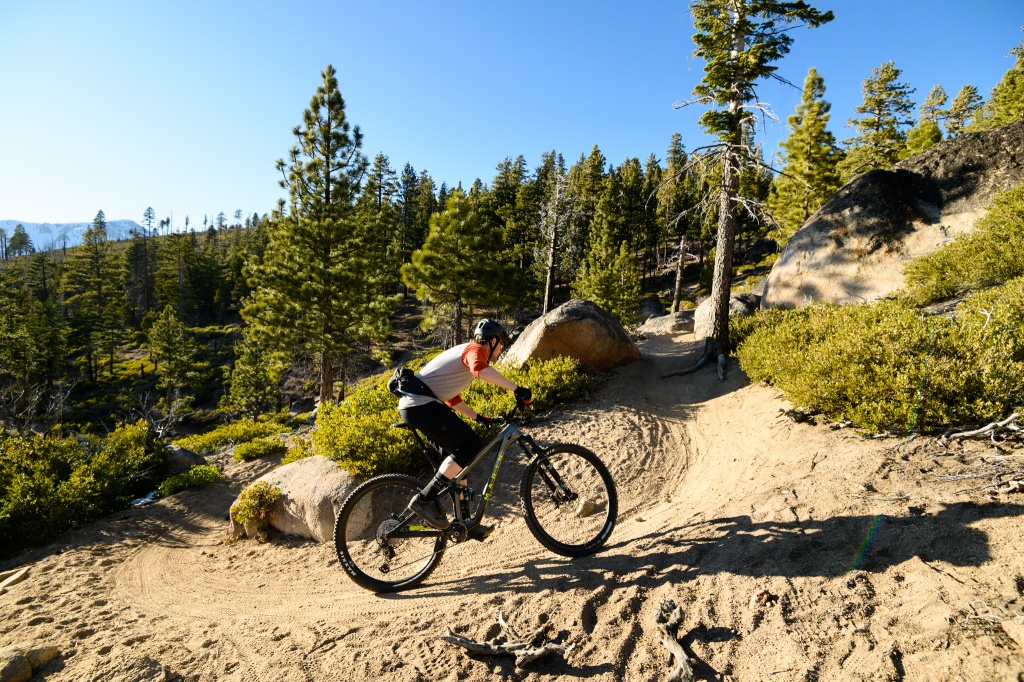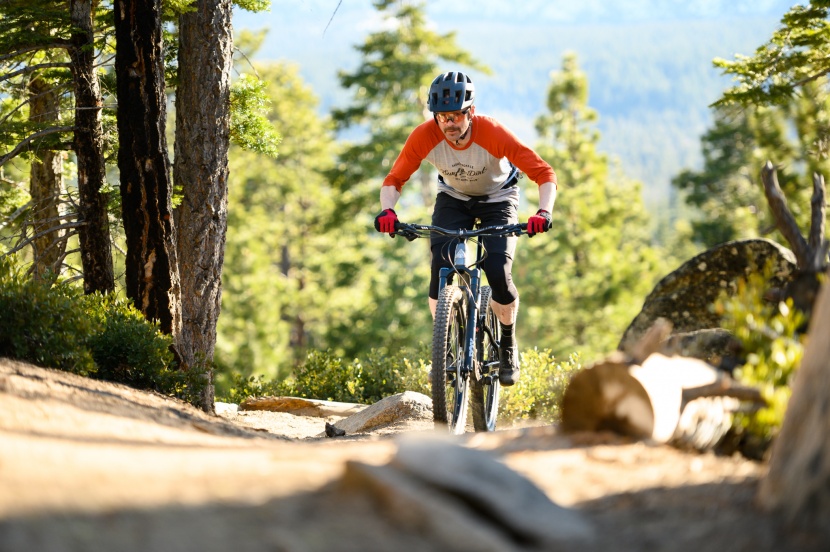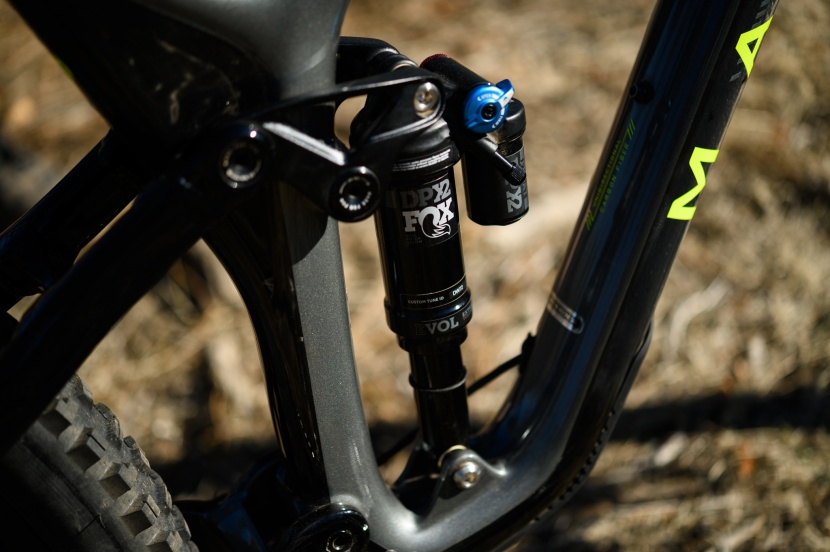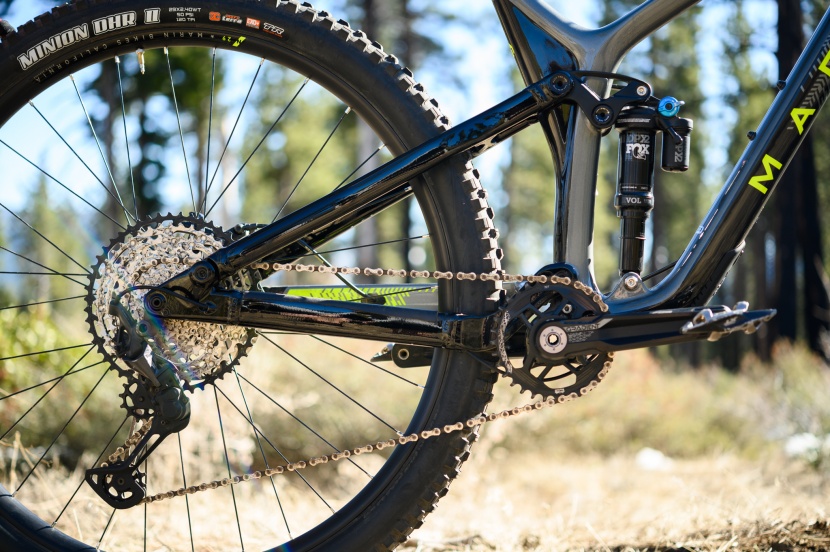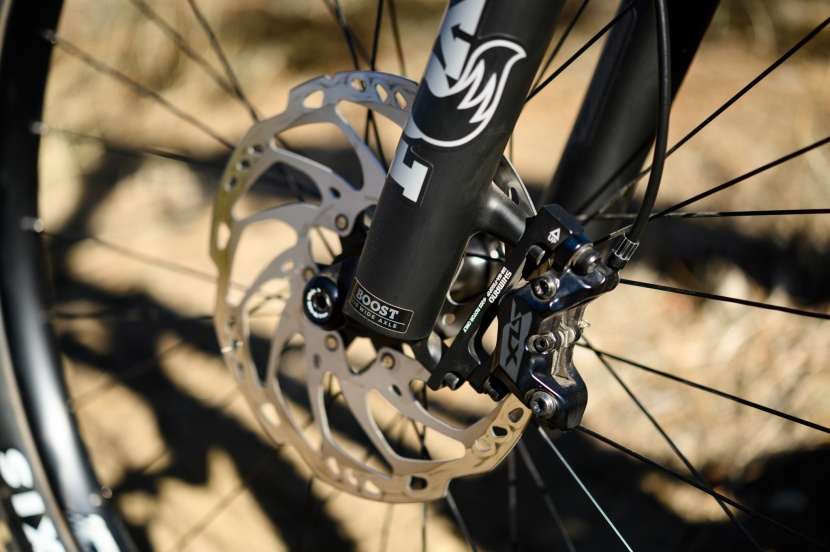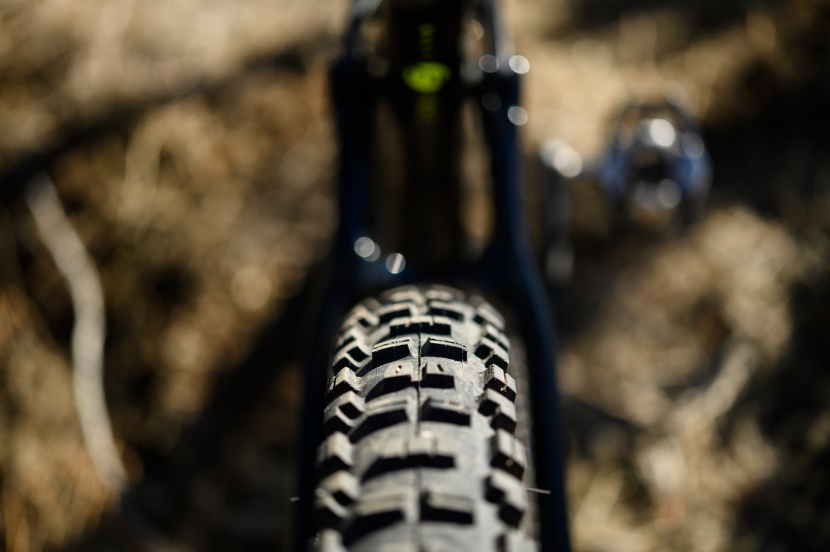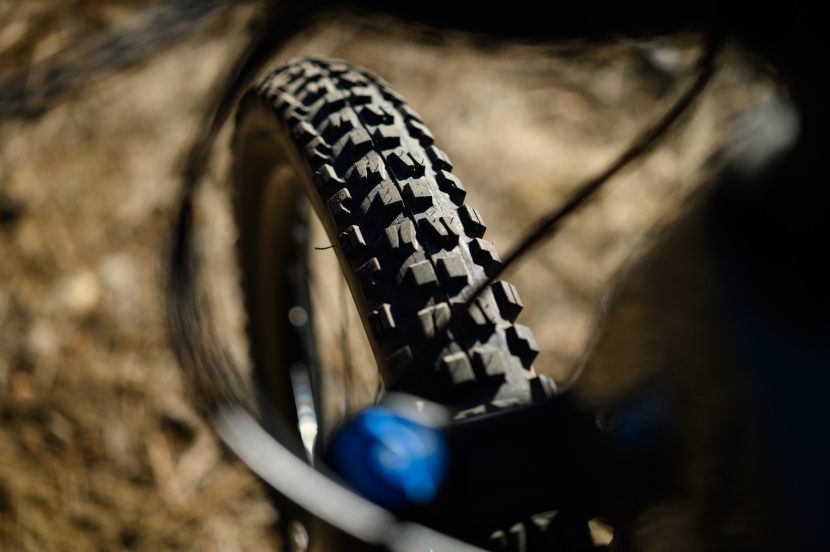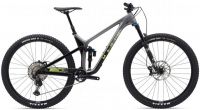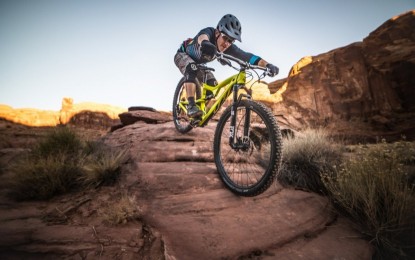
Our Verdict
Our Analysis and Test Results
Should I Buy This Bike
Marin has long been known for pumping out quality bikes at amazing prices, but they recently entered the premium short-travel trail bike market with their new Rift Zone Carbon models. Previously, the Rift Zone was only available with an aluminum frame, but the new carbon models feature a Unidirectional Carbon front triangle paired with an alloy rear end. This 29er pairs 125mm of rear-wheel travel and a 130mm fork with a long and slack modern geometry that capable of charging hard on the descents. Testers found the Rift Zone to feel especially quiet, calm, and composed at speed, over chop and chunder, and when pointed down rowdier terrain. Handling is intuitive and responsive, and it can pick through technical terrain and rail corners with the best of 'em. The Rift Zone isn't the most impressive climber in its travel class, but its efficiency improves dramatically with the use of the rear shock's climb switch. It also comes with a very nice build for the price that enhances its performance on both the climbs and descents. If you're after a super capable shorter-travel trail bike and are interested in trying something different, we feel the Rift Zone Carbon 2 is an intriguing new option and a solid value.
It would be hard not to compare the Rift Zone Carbon 2 to the new Santa Cruz Tallboy. The Tallboy is another short-travel 29er with aggressive angles that's keen to party on the descents. It has 120mm of rear suspension paired with a 130mm fork, and its geometry is strikingly similar to that of the Rift Zone. The Tallboy's reach is 10mm shorter, plus it has flip-chips to adjust the geometry ever so slightly. Both bikes are outrageously capable on the descents and punch well above their short travel class with excellent stability and confidence in steep and rough terrain. We found the most significant difference is the Tallboy's VPP suspension design that provides a super supportive pedal platform and a more progressive curve that has stellar deep stroke support. We feel the Santa Cruz is a more efficient climber, plus it weighs about a pound less. Carbon Tallboy models start at $4,199.
The new Ibis Ripley is another interesting comparison to the Rift Zone Carbon 2. The Ripley has 120mm of rear travel and a 130mm fork, with similar measurements to both the Rift Zone and the Santa Cruz Tallboy, mentioned above. The Ripley sets itself apart with a 66.5-degree head tube angle, a full degree steeper, that gives it super quick, sporty, and more lively feel. Its DW-link suspension design has a very refined feel, excellent small bump compliance, and a calm pedal platform. The Ripley climbs as well as it descends, and this well-rounded bike is only marginally less hard-charging in rowdy terrain than the Rift Zone. The Ripley comes with a full carbon frame, and the GX Eagle model we tested weighed almost three pounds less than the Marin. Ripley models start at $4,099.
Frame Design
The new Rift Zone Carbon 2 is built around Marin's Unidirectional Carbon Fiber front triangle that is paired with a Series 4 Alloy rear triangle. It has 125mm of rear suspension controlled by the MulitTrac suspension platform. MultiTrac is a linkage driven single pivot design that has the main pivot located just above the bottom bracket, pivots on the seat stays just above and forward of the rear axle, and a rocker link attached about halfway up and slightly forward of the seat tube. Brake, derailleur, and dropper cables route internally, and there is space for an external stash box or water bottle
When we measured our large test bike, we found that it had a 630mm effective top tube length and relatively long 480mm reach. The head tube angle was 65.5-degrees with a 76-degree effective seat tube angle. The bottom bracket sits 338mm off the ground with a moderate length 1212mm wheelbase and short 425mm chainstays. It tipped the scales at 31 lbs and 9 oz setup tubeless and without pedals.
Design Highlights
- Comes in carbon fiber (tested) and aluminum frames
- 29-inch wheels only
- 120mm of Multi-Trac rear suspension
- Designed around a 130mm reduced offset fork
- Internal cable routing
- Integrated downtube and chainstay protection
- Available in sizes S-XL
Downhill Performance
The Rift Zone Carbon 2 joins a quickly growing group of shorter travel trail bikes with aggressive geometries that are an absolute blast to ride downhill. This bike is quick, responsive, and has the angles to charge down anything you're willing to point it down. Like most bikes in this travel class, the Rift Zone is limited slightly by its modest travel numbers, but its geometry and component specification certainly won't hold you back.
Marin didn't mess around when they designed the Rift Zone, giving it a nice long reach and a slack 65.5-degree head tube angle. Head tube angles that slack were virtually unheard of on shorter travel bikes until the past few years. Nowadays, many manufacturers have realized the benefits of aggressive geometries on bikes like the Rift Zone. In addition to the slack head tube, the long-ish 480mm reach speaks to this bikes downhill slaying intentions, and carry a head of steam or rolling into something steep is calm, composed, and confident. This bike is absolutely ready, willing, and able to attacks steep and rocky terrain aggressively. Due to its shorter travel numbers, it still encourages good line choice as it can't bail you out the way a longer travel bike can. Steering is direct, and the Rift Zone responds quickly to rider input. Testers found that a centered body position, subtle weight shifts, and tipping the handlebar were all it took to shred through flowing sections of trail. The moderate length 1212mm wheelbase and short 425mm chainstays also help to keep the Rift Zone easily maneuverable in tight terrain, and this bike destroys corners. While it is quick and relatively agile, this bike doesn't promote a particularly playful downhill experience, and it never felt especially eager to manual or catch air off every bump in the trail.
Marin's MultiTrac suspension design controls the 125mm of rear-wheel travel along with a Fox Float DPX2 Performance shock. The DPX2 is an excellent shock and great spec at this price point. The rear suspension felt supple and very sensitive, and small bump compliance was excellent. Testers noted that it had a relatively linear feel, and it wasn't as supportive in the mid-stroke as they'd like, although there was enough ramp-up at the end to prevent harsh bottom outs on bigger hits. We didn't have a larger volume spacer handy during our test period, but we imagine we could have tuned the rear suspension to our liking with some workshop fiddling. We attribute some of the lack of playfulness mentioned above to the less supportive mid-stroke of the rear suspension, and it felt like it would almost suck the pop out of the back end when you tried to load it up. That said, it felt great at speed and helped give the bike its calm, stable, and ground-hugging demeanor. The Fox Float 34 Performance fork felt good on the front end of the Rift Zone, although considering how hard you can shred downhill on this rig it would be nice to see it equipped with something a little sturdier.
Marin did a great job when they chose the components for the Rift Zone Carbon 2, and they nailed some of the more important aspects of the build. The 4-piston Shimano SLX brakes are quite powerful and have an excellent lever feel. The Maxxis Minion DHF/DHR II tire combo with the EXO+ casing is also fantastic and capable of standing up to the most rugged trails. These tires provide excellent cornering and braking traction, and the EXO+ casing is supportive and feels very durable. The cockpit setup is also pretty spot on with a nice 787mm wide Deity Skyline handlebar and a super short stem. Our size large test bike came with a 150mm X-Fusion Manic dropper, which is nice, but our tall testers would've preferred a longer travel option. The PNW Loam lever is a fantastic dropper remote with a light lever feel but has a long throw when paired with the X-Fusion dropper. The Fox Float 34 fork was generally adequate, although it can feel a bit overwhelmed when the going gets super rough.
Uphill Performance
The Rift Zone Carbon 2 is a good climber, but it's not this bike's strongest suit. As a short travel bike, it climbs well enough to get you up just about anything, but its less refined suspension platform and heavy-for-carbon weight don't make it a standout. This bike benefits greatly from the use of the climb switch on the rear shock, which helps to add a little more support at the top of the stroke both when seated or out of the saddle.
When you look at the geometry of the Rift Zone Carbon 2, it's pretty clear that downhill performance was a priority with a long reach and slack head tube angle. At the same time, they gave it a properly steep effective seat tube angle of 76-degrees, which is right on the money by today's standards. That said, the actual set tube angle is a little slacker than that, and when sagged into the rear suspension, our taller testers found themselves a little more over the back wheel than they'd like. Combine that with the short 425mm chainstays, and the front end was prone to wandering on super steep climbs. In those situations, we found the need to shift the weight way forward, and thankfully the generous 480mm reach allowed for that. On more gradual pitches, the Rift Zone is comfortable and carries speed well. It's also highly maneuverable thanks to its short chainstays, moderate length wheelbase, and reduced offset fork. Switchbacks and technical uphill terrain are easily negotiated.
For a carbon-framed bike, the Rift Zone Carbon 2 is a little on the heavy side at 31 lbs and 9 oz. This weight isn't egregious, but comparably priced competitors come in a pound or two lighter. If you're not accustomed to a lighter bike, you might never notice, but on longer sustained climbs or big days of pedaling, the extra heft might slow you down a little. The MultiTrac suspension design is quite active, and there was a fair amount of pedal bob when seated climbing and quite a bit when out of the saddle with the shock in the open position. Switching the shock to the middle/trail position helped greatly and provided a more supportive pedal platform. We've also read other reviews where people have added a larger volume spacer in the shock to remedy this, though we didn't have a chance to try that for ourselves. Either way, if you're not opposed to flipping the climb switch, you can improve this bike's efficiency on the climbs.
Generally speaking, the components of the Rift Zone Carbon 2 perform very well on the climbs. The standout spec was the 12-speed SLX/XT drivetrain. We've become very accustomed to SRAM's mid-range 12-speed options, and while Shimano may have shown up late to the party, they came dressed to kill. The Shimano shifting is very smooth and precise, and it works very, very well, plus it provides a touch more range with its 10-51-tooth cassette. The Marin branded saddle was also surprisingly comfortable for anything from short laps to mega days deep in the backcountry. While a touch heavy, the Maxxis Minion DHR II EXO+ rear tire provided heaps of pedaling traction, even in the loosest of soils.
Photo Tour
Value
At a retail price of $4,400, we feel that the Rift Zone Carbon 2 is competitively priced amongst short travel trail bikes, especially considering the quality of the build. The fact that this bike comes with a Fox Float DPX2 shock and Float Performance fork is impressive; add to that a Shimano SLX/XT drivetrain and 4-piston SLX brakes, and you can see the value added over the budget builds of similar competitors. If the carbon model is too spendy, there are three very reasonably priced aluminum-framed models to choose from.
Conclusion
The Rift Zone Carbon 2 is a great new shorter travel trail bike with a progressive geometry that has a preference for the descents. Despite having only 125mm of rear-wheel travel and a 130mm fork, the Rift Zone is super capable and ready to ride as aggressively as you want. At speed, the bike remains stable and doesn't elicit fear. Its uphill performance is a little less exciting, but it climbs well enough, especially when you use the climb switch. It also comes with a nicer build than most of the competition at this price point, and we think it represents a pretty good value. We feel this is an impressive new addition to the growing pool of aggressive short-travel bikes.
Other Versions
Marin makes the Rift Zone in both carbon fiber and aluminum frames. The other carbon model is the Rift Zone Carbon 1, $3,500, and shares the same frame and geometry as the model we tested. It comes nicely equipped with a Marzocchi Z2 fork, Fox Float DPS shock, Shimano SLX 12-speed drivetrain, and Shimano MT420 4-piston brakes.
They make three aluminum-framed models that share the same geometry as the carbon models. The Rift Zone 3, $2,650, comes with the same build as the Carbon 1 mentioned above.
The Rift Zone 2, $1,950, comes with a RockShox Recon RL and a Deluxe Select R shock. The drivetrain is a SRAM SX 12-speed, with Shimano MT201 brakes and Vee Tires Flow Snap tires.
The Rift Zone 1, $1,600, is a very affordable full-suspension bike. It comes with a RockShox Recon RL fork, an X-Fusion 02 Pro R shock, a Shimano Deore 11-speed drivetrain, Shimano MT201 brakes, although it doesn't come with a dropper seatpost.| Awards | |
|---|---|
| Price | $4,400 List |
Overall Score  |
|
| Star Rating | |
| Bottom Line | The Rift Zone Carbon 2 is fun short travel trail bike with the angles to get aggressive |
| Pros | Nice build, modern geometry, plush suspension, quick/maneuverable, hard charging downhill performance |
| Cons | Linear rear suspension feel, a little heavy for carbon, not the sportiest climber |
| Rating Categories | Marin Rift Zone Carb... |
| Fun Factor (25%) | |
| Downhill Performance (35%) | |
| Climbing Performance (35%) | |
| Ease of Maintenance (5%) | |
| Specifications | Marin Rift Zone Carb... |
| Wheel size | 29" |
| Suspension & Travel | MultiTrac Suspension - 125mm |
| Measured Weight (w/o pedals) | 31 lbs 9 oz (Large) |
| Fork | Fox Float 34 Performance 130mm 34mm stanchions |
| Shock | Fox Float DPX2 Performance EVOL |
| Frame Material | Carbon Fiber |
| Frame Size | Large |
| Frame Settings | N/A |
| Available Sizes | S-XL |
| Wheelset | Marin Aluminum Double Wall rims 29mm ID with Shimano hubs |
| Front Tire | Maxxis Minion DHF EXO+ 2.5" WT |
| Rear Tire | Maxxis Minion DHR II EXO+ 2.4" WT |
| Shifters | Shimano SLX 12-speed |
| Rear Derailleur | Shimano XT 12-speed |
| Crankset | FSA Gradient 32T |
| Saddle | Marin Trail Speed Concept Pro |
| Seatpost | X-Fusion Manic 150mm w/ PNW Loam lever |
| Handlebar | Deity Skyline 787mm 25mm rise |
| Stem | Marin 3D forged alloy |
| Brakes | Shimano SLX |
| Measured Effective Top Tube (mm) | 630 |
| Measured Reach (mm) | 480 |
| Measured Head Tube Angle | 65.5-degrees |
| Measured Seat Tube Angle | 76-degrees |
| Measured Bottom Bracket Height (mm) | 338 |
| Measured Wheelbase (mm) | 1212 |
| Measured Chain Stay Length (mm) | 425 |
| Warranty | Five Years |


